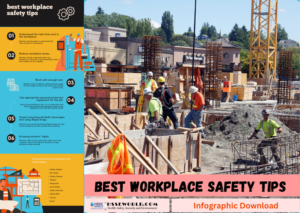Oil & extraction: hazards, controls & resources -Safety Moment#22
6 min readAccording to Bureau of Labor Statistics (BLS) data, in 2016 there are currently between 150,000 and 160,000 people employed in oil & gas extraction in the United States. The most common careers in the energy & oil industry include geoscientists; petroleum engineers; petroleum pump system operators, refinery operators, and gaugers; roustabouts (oil and gas); and wellhead pumpers.
According to OSHA, 489 oil and gas extraction workers were killed on the job between 2013 and 2017, making this a pretty dangerous industry.
Leading Causes of Fatalities in the Oil & Gas Extraction Industry
OSHA lists the following as the most common causes of fatalities that occurred during oil and gas extraction work processes:
- Vehicle accidents
- Struck-by/caught-in/caught-between
- Explosions and fires
- Falls
- Confined spaces
- Chemical exposures
Additional Common Hazards in Oil & Gas Extraction
In addition to the hazards commonly associated with fatalities in the industry listed above, OSHA also lists the following as common hazards in oil & gas extraction:
- Ergonomic hazards
- High-pressure lines and equipment
- Electrical and other hazardous energy
- Machine hazards
- Planning and prevention (I believe they mean poor planning and prevention and/or no planning and prevention here)
A Closer Look at the Oil & Gas Extraction Hazards
Let’s take a closer look at each of the hazards listed above.
Motorized Vehicle Accidents
It’s common that oil & gas extraction workers and equipment need to be transported to well sites that are quite remote. And likewise, this need for transportation often leads to motor vehicle accidents and fatalities. In fact, OSHA notes that just around 40% of fatalities in this industry are from highway vehicle incidents.
To reduce these fatalities (as well as injuries), check OSHA’s Motor Vehicle Safety webpage; NIOSH’s Motor Vehicle Safety webpage; these tips on prevention strategies re: work-related roadway crashes from CDC & NIOSH; and this NIOSH fact sheet to help oil & gas workers avoid fatigued driving at work.
Remember that common causes of these accidents include fatigue, use of drugs and alcohol, unsafe driving, and driving in poor climate conditions.
Struck-by/Caught-Between/Caught-In
Struck-by/caught-in/caught between hazards are a major cause of fatalities in the oil and gas industries.
Sources of these hazards include moving vehicles, mobile equipment, falling equipment, and high-pressure lines (which we’ll discuss again a little further down this list).
You may find the following materials helpful in identifying and mitigating these hazards:
- OSHA’s Harwood Grant Training Materials includes training specific to struck-by incidents in the oil and gas industry
- OSHA’s Crane, Derrick & Hoist safety and health topic webpage gives lots of great information to reduce these hazards
- OSHA’s Oil Well Derrick Stability: Guywire Anchor Systems technical manual provides valuable guidance
Explosions and Fires
The presence of flammable and/or combustible vapors and gases and numerous potential ignition sources make explosions and fires a real concern in oil and gas extraction.
Prevention begins with knowing the flammable/combustible qualities of the materials being extracted and/or worked with, and continue to understanding the potential of tools and equipment to cause ignition.
Here are some useful resources for hazard ID and control:
- OSHA offers an eTool to help identify oil and gas drilling ignition sources at wells
- OSHA’s Oil & Gas Drilling and Servicing eTool helps explain hot work, fire, and explosive hazards involved in oil and gas drilling
- OSHA, the National Steps Network, and the NIOSH Alliance created this hazard alert titled Hot Work in Oilfields that explains how to prevent fatalities in tanks, tankers, and similar equipment
- This OSHA bulletin informs people who work in oil and gas about the flammability of oilfield waste liquids
- This OSHA bullet informs people of the possibility that static electricity can build up in plastic pipe, leading to fires.
- OSHA’s Fire Safety safety and health topic webpage also has a lot of great materials on this topic
Falls
Falls are a significant cause of fatalities in all workplaces in the US, and that’s no different in energy & oil extraction, especially when workers have to get on platforms and other equipment located high above the ground.
Some of the best ways to avoid falls in this work environment include re-engineering the work some working at heights is not required; using fall prevention & protection properly; and making sure workers are aware of the fall hazards and controls.
To help with this, you may find our Fall Prevention & Protection Toolbox Talk Checklist helpful.
Confined Spaces
There are many confined spaces in the oil and gas extraction industry, and workers often enter them: storage tanks, mud pits, reserve pits, sand storage containers, and more.
These confined spaces bring with them a multitude of hazards & risks, including ignition, asphyxiation, and hazardous chemical exposure.
In many cases, OSHA requires confined spaces be entered only with a permit (permit-required confined space). In these cases, the atmosphere must be tested in advance and monitored continuously during the entry.
Here are some additional useful resources for working around and in confined spaces in the oil and gas industry:
- OSHA’s Confined Spaces Safety and Health Topics webpage
- This OSHA/Harwood Grant Training Materials piece that specifically covers confined space entry in the oil and gas industry and this one that specifically covers permit-required confined space entry in the oil and gas industry
Ergonomic Hazards
Workers in the oil and gas industry face many of the same types of ergonomic hazards that workers in other fields that require heavy physical labor face. These include MSDS-injury risks form lifting, bending, and reaching; from pushing and pulling heavy objects; from working in awkward body postures; and from repeated motions and tasks.
In many cases, these ergonomic hazards can be reduced easily enough by making use of the right tools, placing materials appropriately to reduce strain, training workers about the hazards, encouraging workers to quickly report symptoms, and performing pre-task planning.
The following OSHA and NIOSH documents provide guidance on recognizing and controlling these hazards:
- Strains and Sprains. OSHA’s Oil and Gas Well Drilling and Servicing eTool. Lists solutions for preventing strains and sprains in the oil and gas industry.
- Ergonomics. OSHA Safety and Health Topics Page. Covers related standards and guidelines for preventing ergonomic injury.
- Ergonomics and Musculoskeletal Disorders. National Institute for Occupational Safety and Health (NIOSH) Workplace Safety & Health Topic. Lists NIOSH publications and current research into ergonomics.
High-Pressure Lines and Equipment
Compressed gases and high-pressure lines are common in the oil and gas industry. These bring with them a range of hazards, especially if they’re improperly used, stored, handled, maintained, or inspected. For example, high-pressure lines can corrode, leading to leaks or bursts that can harm workers. Likewise, the connections between lines can also fail, causing the line to flail and creating struck-by injuries in addition to exposure risks.
Here are some useful resources for working safely around high-pressure lines and equipment in the oil and gas industry:
- OSHA’s Compressed Gas and Equipment Safety and Health Topic webpage
- OSHA’s Pressure Vessels Safety and Health Topics webpage
Electrical and other Hazardous Energy
Uncontrolled hazardous energy can be a serious risk for oil and gas workers. Of course, prevention begins with proper prevention through design and appropriate use of the hierarchy of controls.
Here are some helpful resources for identifying and controlling sources of hazardous uncontrolled energy:
- OSHA’s Lockout/Tagout & Control of Hazardous Energy Safety and Health Topic webpage
- Training materials from OSHA’s Hardwood Grant Training Materials on hazardous energy in the oil and gas industry and on lockout/tagout in the oil and gas industry
Always remember that uncontrolled energy sources are a potentially deadly hazard.
Machine Hazards
Workers in the oil and gas industry work with and/or near a wide variety of machines with moving parts that present struck-by and caught-between hazards, especially if they’re unguarded (during normal operations or during maintenance).
Proper machine guarding is key, and so is training to alert workers to the hazards and teach them safe ways to work near this machinery.
Planning and Prevention (Lack of and/or Inadequate)
Of course, in all aspects of occupational safety, it pays to plan and prepare before performing hazardous work.
It also pays to do planning on a scope that looks beyond specific job tasks, including creating and putting into effect safe work procedures for the following (many of which are required for OSHA compliance anyway):
- Working in confined spaces
- Trenching and excavation safety
- Chemical storage
- Chemical handling
- Chemical exposure
- Working with electricity
- Emergency response
- Equipment & machine
- Fall protection
- Fire safety, including proper use of a fire extinguisher
- Safety during welding and other hot-work activities
- PPE use
- Working near power sources, including electrical safety and lockout/tagout
- Heat stress
- Cold stress
- Fatigue
- Drug and alcohol use




